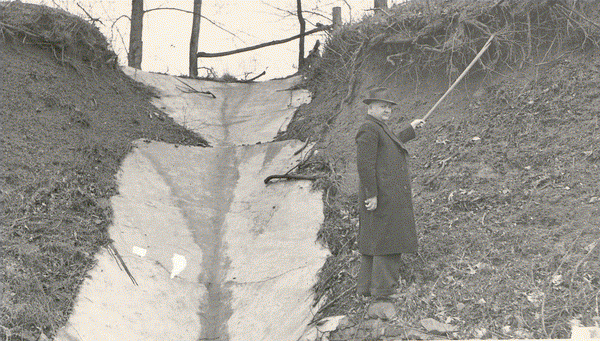
LANDSCAPE DESIGN BLOOMS ON MARYLAND ROADSIDES
by Clayton Davis
It is no accident that Maryland's highways are some of the most beautiful in the United States. It was during the Great Depression, in the 1930s, when Mr. Sylvester Baumiller started it all. He was a motorcycle policeman, known as "Bud" to everyone in Maryland. Bud Baumiller knew way back then that trees and shrubs planted alongside highways would prevent erosion, serve as sound barriers, and provide pleasant relief to the eyes of motorists.
Photo provided by Mark Charney, SHA history researcher
Mr. Sylvester Baumiller

The Federated Garden Clubs of Maryland erected a plaque to Bud Baumiller on October 14, 1970. It is the centerpiece of a Rest Area on the eastbound side of Interstate-70 between Hagarstown and Frederick.
The Rest Area is named for S. W. Baumiller and the plaque is inscribed: "First Landscape Engineer with the Maryland State Roads Commission. His dedication to roadside beauty has made Maryland a better place in which to live. The Federated Garden Clubs of Maryland, October 14, 1970."
There is a photograph of a beloved U.S. Congressman from Maryland among the many comfortable amenities inside the Baumiller Rest Area.
The dedication reads: "The Honorable Goodloe E. Byron, 1929 - 1978. Host, Mentor and Coordinator of the South Mountain Visitor Center. Congressman Byron was a dedicated and tireless worker for all in Frederick County and the State of Maryland. This Center exists so others may share and appreciate the history, environment, and beauty of Frederick County which he so cherished."
Bud Baumiller retired in the early 1960s. His efforts were continued by Charles Anderson who also retired from the Maryland Highway Administration in the late 1980s, but still serves as a consultant to the Highway Administration.
Today the position is headed by William Kuhl, Division of Landscaping. Bruce Knott is responsible for wildflowers, trees, shrubs and cover crops.
A lot of thought and coordination goes into making a highway. If more than one acre of land will be disturbed during construction, the Division of Landscaping gets involved. The first concern will be archeological and historical preservation. Old mills, bridges, and barns receive special attention.
Embankments are tilled and terraced. Foliage is chosen to blend with Maryland's indigenous growth. Topsoil is stockpiled during excavation to be spread back upon the prepared area, then the soil's character is analyzed. Lime is sometimes added to achieve the correct balance. Three to five years later another soil sample will be taken and appropriate nutrients spread in and around the growing plant life.
Small pits are dug as tilling and terracing are in progress. Tree seedlings are planted in the small pits, surrounded by a cardboard container called a "Tubex". For awhile these cardboard Tubexes stand like lonely sentinels as they wait and protect the helpless sprigs that will become magnificent trees for all to enjoy. A solution of treated sewage sludge is used as fertilizer to jump-start the baby trees.
The tilled and terrace surface is then hydro-seeded. It is a spraying operation that makes the ground look like it has been painted green. It has in fact been painted green, using shredded, recycled newspapers that are soaked in an environmentally neutral, light green pigment.
Very soon you will see grass start to grow with enthusiasm, because grass and wildflower seeds were added to the hydro-seed mixture. The shredded paper acts like mulch to shield the young plants as they get a start, keeping them cozy and protected until seeds can burst forth with new life.
Grasses and plants are selected that serve two purposes. They are beautiful and will prevent erosion. The Maryland Highway Administration selected Sheep Fescue, a perennial grass, for its hardiness. Crown Vetch, very tenacious with magnificent blossoms, has roots that grab the soil and hang on.
Three different wildflower seed mixtures are planted. As you travel from the mountains in Western Maryland across the rolling countryside to the Eastern Shore, Snapdragons, Black-Eyed Susans, English Wallflowers, and Tall Evening Primroses can be seen in glorious arrays from season to season.
An assortment of woody-shrub seed containing Sumac is included in the sprayed hydro-seed mix. Sumac grows fast, celebrating Spring very early and then sings with magnificent color in Autumn. After only a few years, Maryland's natural vegetation begins to creep in and take over.
Trees are selected for blossom color in Spring, shade and appearance during Summer, and the foliage display in Autumn. Many of the old growth woods in Maryland are Oak and Maple. They are therefore an appropriate choice for highway landscaping. Because mature standing trees are a direct indicator of soil conditions, predominance of particular species varies accordingly.
After Oak and Maple establish themselves alongside highways, reseeding takes place through natural activities of birds and animals. Sometimes this allows aggressive and undesirable trees such as Black Locust to overwhelm the beautiful Oak and Maple. When unwelcome growth starts to get the upper hand, the Landscaping Division will begin strategic cutting and trimming activities.
Tourists traversing the state or staying awhile, residents using the roads daily, all enjoy and benefit from the care and forethought given to building Maryland's thoroughfares. The nineties are an age of heightened environmental awareness and nestled in the east coast's urban sprawl is a delightful example of mankind's progress in harmony with nature -- Maryland Highway Landscaping.
- THE END -

 RETURN TO MAIN PAGE
RETURN TO MAIN PAGE